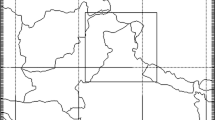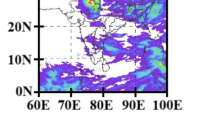Abstract
In the present study, diagnostic studies were undertaken using station-based rainfall data sets of selected stations of Guyana to understand the variability of rainfall. The multidecadal variation in rainfall of coastal station Georgetown and inland station Timehri has shown that the rainfall variability was less during the May–July (20–30%) of primary wet season compared to the December--January (60–70%) of second wet season. The rainfall analysis of Georgetown based on data series from 1916 to 2007 shows that El Niño/La Niña has direct relation with monthly mean rainfall of Guyana. The impact is more predominant during the second wet season December--January. A high-resolution Weather Research and Forecasting model was made operational to generate real-time forecasts up to 84 h based on 00 UTC global forecast system (GFS), NCEP initial condition. The model real-time rainfall forecast during July 2010 evaluation has shown a reasonable skill of the forecast model in predicting the heavy rainfall events and major circulation features for day-to-day operational forecast guidance. In addition to the operational experimental forecast, as part of model validation, a few sensitivity experiments are also conducted with the combination of two cloud cumulus (Kain--Fritsch (KF) and Betts–Miller–Janjic (BMJ)) and three microphysical schemes (Ferrier et al. WSM-3 simple ice scheme and Lin et al.) for heavy rainfall event occurred during 28–30 May 2010 over coastal Guyana and tropical Hurricane ‘EARL’ formed during 25 August–04 September 2010 over east Caribbean Sea. It was observed that there are major differences in the simulations of heavy rainfall event among the cumulus schemes, in spite of using the same initial and boundary conditions and model configuration. Overall, it was observed that the combination of BMJ and WSM-3 has shown qualitatively close to the observed heavy rainfall event even though the predicted amounts are less. In the case of tropical Hurricane ‘EARL’, the forecast track in all the six experiments based on 00 UTC of 28 August 2010 initial conditions for the forecast up to 84 h has shown that the combination of KF cumulus and Ferrier microphysics scheme has shown less track errors compared to other combinations. The overall average position errors for all the six experiments taken together work out to 103 km in 24, 199 km in 48, 197 km in 72 and 174 km in 84 h.
















Similar content being viewed by others
References
Ferrier BS, Jin Y, Lin Y, Black T, Rogers E, DiMego G (2002) Implementation of a new grid-scale cloud and precipitation scheme in the NCEP eta model. Preprints, 15th conference on numerical weather prediction. American Meteorology Society, San Antonio, pp 280–283
Janjic ZI (1994) The step-mountain eta coordinate model: further developments of the convection, viscous sublayer, and turbulence closure schemes. Mon Weather Rev 122:927–945
Janjic ZI (2000) Comments on development and evaluation of a convection scheme for use in climate models. J Atmos Sci 57:3686
Kain JS, Fritsch JM (1993) Convective parameterization for mesoscale models: the Kain-Fritcsh scheme. In: Emanuel KA, Raymond DJ (eds) The representation of cumulus convection in numerical models. American Meteorology Society, Boston, p 246
Laprise R (1992) The Euler equations of motion with hydrostatic pressure as independent variable. Mon Weather Rev 120:197–207
Lin YL, Farley RD, Orville HD (1983) Bulk parameterization of the snow field in a cloud model. J Appl Meteor 22:1065–1092
Persaud C, Persaud K (1995) The classification of the rainfall regions of Guyana. Caribbean Climate Centre, Barbados
Rama Rao YV, Hatwar HR, Salah Ahmad Kamal, Sudhakar Y (2007) An experiment using the high resolution eta and WRF models to forecast heavy precipitation over India. Pure Appl Geophys 164(8–9):1593–1615
Seulall BD (2005) Variability and trends of daily rainfall and temperature extreme in coastal Guyana. M. Sc thesis, Department of Meteorology, University of Reading, UK
Skamarock WC, Klemp JB (1992) The stability of time-split numerical methods for the hydrostatic and the nonhydrostatic elastic equations. Mon Weather Rev 120:2109–2127
Skamarock WC, Klemp JB, Dudhia J, Gill DO, Barker DM, Duda MG, Huang X-Y, Wang W, Powers JG (2008) A description of the advanced research WRF version 3, NCAR Techical Note-475
Wilson JM, Crook NA, Mueller CK, Sun J, Dixon M (1998) Nowcasting thunderstorms: a status report, B. Am Meteorol Soc 79:2079–2099
Acknowledgments
This work has been carried out as a part of the joint Indo-Guyanese collaborative program supported by Indian Technical and Economic Cooperation (ITEC) Program, Ministry of External Affairs, Government of India, New Delhi. The first author gratefully acknowledges the Ministry of External Affairs, Government of India and Director General of Meteorology, India Meteorological Department, New Delhi, for deputing to Hydrometeorological Service, Georgetown, Guyana, as an ITEC expert to work on this project.
Author information
Authors and Affiliations
Corresponding author
Rights and permissions
About this article
Cite this article
Rama Rao, Y.V., Alves, L., Seulall, B. et al. Evaluation of the weather research and forecasting (WRF) model over Guyana. Nat Hazards 61, 1243–1261 (2012). https://doi.org/10.1007/s11069-011-9977-3
Received:
Accepted:
Published:
Issue Date:
DOI: https://doi.org/10.1007/s11069-011-9977-3




